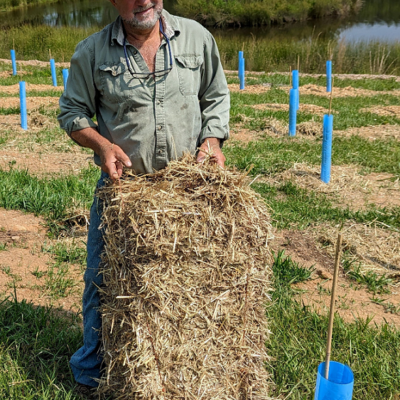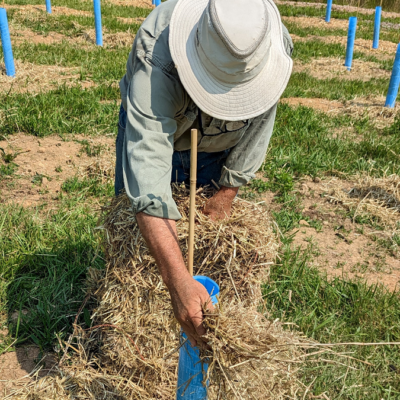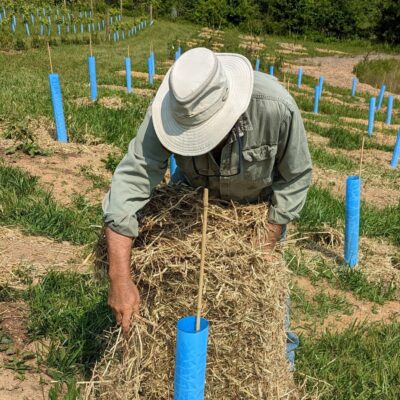(or, Mulch Ado About Nothing!)
A mulch is a material that covers the earth. In woodlands, fallen leaves form an organic mulch. Organic mulches are food for “worms”, which here include the soil microbiota and soil macro-biota. The microbiome consists of the microscopic soil dwelling organisms including bacteria, fungi, nematodes, mites and so on. The macro-biota consists of earthworms, soil-dwelling insects, moles, and so forth. These earth dwellers help breakdown organic matter to humus. Their activities aerate the soil, which increases water infiltration, drainage and gas exchange. Moisture, gas exchange and a well-drained soil are essential for healthy root development. This system occurs naturally. To garden successfully, simply mimic the natural system.
Organic versus Inorganic Mulches
Organic mulches are derived from once living organisms. Inorganic mulches are the result of synthetic manufacture. Both are used to cover the ground, and though some of the functions overlap, there are pros and cons to each.
The Pros and Cons of an Organic Mulch
Organic mulches:
- Suppress weeds
- Reduce evaporation from the soil surface
- Add organic matter
- Slow the warming of soils in spring
- Allows for water infiltration and gas exchange
- Requires annual or biennial application
Inorganic mulches
- Suppress weeds
- Reduce evaporation from the soil surface
- Do not add organic matter
- Warm soils in early spring
- Unless it is a woven fabric, limits water infiltration and gas exchange
- Results in plastic waste
Types of Organic Mulches
There is a number of organic mulches from which to select. The choices can be daunting. However, in gardening, the basic choices are sometimes the best including:
- Bark chips
- Woodchips
- Pine Straw
- Wheat Straw
Bark Chips or Woodchips?
Bark chips are most often used in landscape plantings. It is composed primarily of suberin (cork). Unlike wood chips, it is slow to break down and does not add much organic matter to the soil. In addition, suberin repels water, and when applied could impede water infiltration. It is used, or more correctly, overused and often dyed. Bagged for convenience, or offered in bulk, its use is based on improving the aesthetics of a landscape.
Wood chips are the by-product of tree trimming or tree removal. Some chippers can chip whole trees, some to 24” in diameter! Whole tree chips tend to be more uniform in size and nicer to work with. Chips from brush (limbs) tend to be stringy, and more difficult to work with. However, don’t discount chipped brush out of hand. Stringy material ought to be selected for use on sloped sites, as it is less prone to washing away in hard rains. They are superior to woodchips for erosion control, and using a mulch fork makes handling easier.
Whole tree chips, on the other hand, are more uniform in size and have a place in the landscape that is not prone to erosion. Use woodchips in mixed tree and shrub plantings and in foundation plantings.
A significant difference in bark and wood chips is the cost. The most costly are bagged bark chips. While bulk bark chips will save you dollars, they will save you nothing in hauling and spreading. The best deal is of course wood chips, as you can often get these delivered free or nearly so, from your local arborist.
One word of caution: avoid wood chips from black walnut. Black walnut contains a compound (juglone) that is antagonistic or toxic to some plants including tomatoes, pines and apple trees. Ask your arborist for chips free of black walnut.
Carbon to Nitrogen Ratios
Woodchips have a carbon to nitrogen ratio that is fairly high, variable, but on the order of 200:1. Finished compost is on the order of 20:1. The soil microbiota are comprised of a carbon:nitrogen ratio of about 10:1. Carbon is the structural building blocks of living things and it is also the food for “worms” (the decomposers). Think of carbon as carbohydrate. In plants, cellulose is approximately 50% carbon. On the other hand, nitrogen is the basis of amino acids, proteins, and enzymes that drive life functions. The basic life functions of plants include: growth, metabolism, reproduction, storage and defense (more on that later). When woodchips are broken down (primarily by saprophytes, the fungi and actinomycetes), they add organic matter to the soil.
In native soils, organic matter from leaf decomposition form a top layer that is called the “O-horizon.” This differs from the underlying mineral layers of soil. Organic matter (humus) helps to improve soils in a number of ways including: mineral holding capacity, gas exchange (aeration), and water infiltration. Layered, fresh chips also help soils retain moisture by reducing the evaporative effects of the sun, and regulates temperature by cooling the earth beneath.
Using Fresh Woodchips
Use fresh woodchips. Contrary to popular belief, woodchips applied as a surface mulch will not rob the soil of nitrogen. Go ahead and use them with impunity. Except to say, that whatever mulch you use in the landscape, it is important to cover the earth and not the plant. Keep the mulch well away from the trees’ trunk! Applying a 4 to 6” layer of mulch will help to control weeds, reducing your summer chores.
Fresh wood chips have another advantage of use. In sheltered or shady areas, you can inoculate your woodchips with mushroom spawn, such as wine caps (Stropharia rugosoannulata). This is one of the easier mushrooms to grow, and the suggestion is for my mycophile friends. A word of caution, though: always positively identify any mushroom you forage for or cultivate!
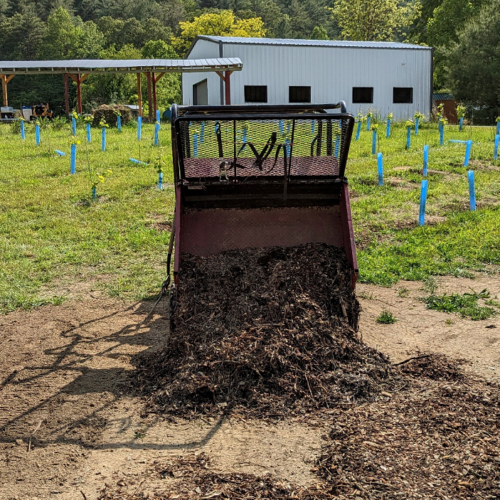
Pine Straw
Select pine straw for use with ericaceous or acid loving plants. Acid loving plants grow in very acidic soils (pH of ~5.0). These include: rhododendrons, azaleas, blueberries, leucothoe, heaths, heathers, andromedas, sourwood, etc. Not surprisingly, pines also grow in acidic conditions! Longleaf, slash and loblolly pines are most often used for pine straw. On slopes, pine straw will help retain soils against the erosive effects of harsh rains. As with brush or woodchips, apply thickly around plants, at least 4 to 6” thick. Most ericaceous plants are shallow rooted, and a thick mulch is a buffer to prevent roots from drying out. Pine straw is lightweight and easier to apply compared to the bulk materials.

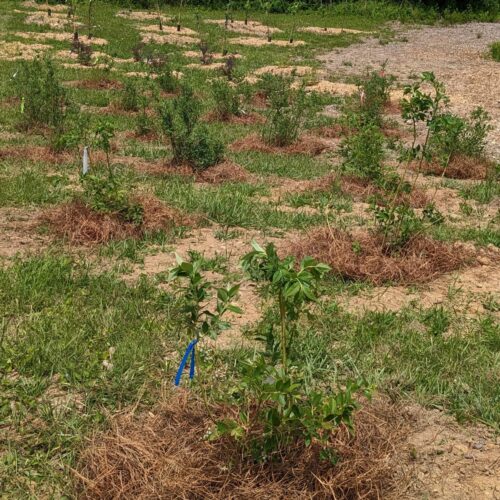
Wheat Straw versus Hay
Both straw and hay come in tied bales. The likeness ends there. Hay has seedheads, whereas straw does not. Save the hay to feed your farm animals (if you have them), but in gardening, use wheat straw. Straw, a dried grass, also has a very high carbon content (about 80:1, according to the USDA). The primary microbial decomposers of straw are soil bacteria. Apply wheat straw as a mulch as you would do with pine straw, except your use is around plants that prefer a moderate soil pH (6.5 to 7.0). These are most of your garden, herb and vegetable plants. It is useful in no till and, especially in tilled applications.
The use of fresh wheat straw has an added advantage as well for the mycophile: oyster mushrooms (Pleurotus ostreatus) prefer straw as a growing media. A reminder: always positively any mushroom you forage for or cultivate!
Using the strings that tie the bales for carrying make transporting wheat straw easy.
Applying wheat straw
Using Wheat Straw in a New Garden Plot
In a plot on our farm, we recently brought up the grade of a low-lying area with a sandy loam soil. A soil analysis showed that the soil pH was low (5.2), and the organic matter content, moderate (3.4%). This graded area formed the base soil for the field planting. The total area of the plot was 1500 square feet (30×50). We brought in composted horse manure, graded out to 1”, then tilled in using our two-wheeled tractor with a power depth roller. The compost was incorporated into the top 5” of soil. The final blend is about 16% compost by volume. Aim for an organic matter addition in the neighborhood of 1 part compost to 6 to 9 parts soil (10 to 15% amendment by volume), depending on your soil texture and the crop you wish to grow.
In our case, the soil was coarse in texture (very well drained) and the plot was then sown to sunflowers, pumpkins and melons, all heavy feeders. We then applied dolomitic limestone to help correct for the low soil pH. The recommended application is 100 lbs. /acre to raise the pH by 1/10 of a point.
To raise pH from 5.2 to 6.7 on 1500 square feet, here is the math simplified: 1000 lbs. /43,560 sq. ft. = recommended rate of 0.023 lbs. /sq. ft. /pH point. To raise the pH of 1500 sq. ft. by 1pH point, we need 34.4 lbs. (1500 x 0.023 lbs. /sq. ft.). To increase to 1.5 pH points (6.7 – 5.2), multiply the result by 1.5, which equals 52 lbs. dolomitic limestone to apply. Easy right? Lastly, wheat straw was distributed liberally between the rows and lightly on the seed row.
Spreading and Tilling Compost
Inorganic Mulches
Black plastic and woven landscape fabric are sometimes used in field plots to keep down weeds and in landscape plantings, respectively. Black plastic is impermeable to air and water, so irrigation lines are laid out at the same time the plastic is laid down. Air to roots may be limiting as black plastic is impermeable to gas exchange. If you decide to use a black plastic mulch, perforate it to allow for gas exchange. Black plastic warms earlier in the growing season compared to organic mulches.
Why Gas Exchange?
Roots have several important functions for plants: anchoring, absorption of water and minerals and forming symbiotic relationships with bacteria (rhizobia) or fungi (mycorrhizae). Conditions that favor symbiosis are good organic matter, and adequate moisture and aeration. Roots grow through the voids between soil particles. The ideal soil condition is 50% particulates, 25% moisture and 25% air space. Of course, this varies widely, seasonally as well as daily! Roots respire, that is, they take in air (a mixture of 78% nitrogen and 22% oxygen) and expel carbon dioxide. The respiratory process is the exact opposite of the photosynthetic process, or to be more precise, the formulas are. Respiration may be summarized as follows: CH2O + O2 à CO2 + H2O. Sugars are metabolized to yield energy for life functions. The by-products of respiration are carbon dioxide and water. If the carbon dioxide remains in solution (forming carbonic acid), the root zone will become increasingly acidic. Worse though, the build-up of CO2 in the pore space will lead to an asphyxiation of roots. Some plants will tolerate poorly aerated soils such as bald cypress (Taxodium distichum) and plants native to hydric (boggy) soils. But these are the exceptions. Most mesic plants require well drained, moist soils for healthy growth and establishment.
Woven Landscape Fabric
Woven fabrics unlike plastics, allow for gaseous exchange. They are used in conjunction with bark mulch, and that may be problematic from the standpoint of water infiltration to plant roots. This combination has its limitations, the most salient is that it contributes little to soil improvement.
It is true that using organic mulches degrade, and therefore require re-application on a biennial basis. Plastic mulches also degrade, but become a source of waste material. If covered with a bark mulch, they last longer. The sole reason for a top dressing is well, “to dress things up a bit.” The organic mulch degrades to humus, encouraging the soil biome and plant-root health. The inorganic mulch at best only degrades itself and at worst, degrades the soil biome and plant-root health. Therefore, choose your degrading materials wisely!
Next week, we get into summer topics.
~ Signing off for now, Joe


